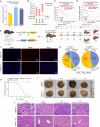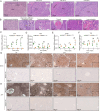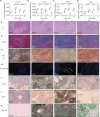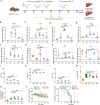Overexpression of wild-type HRAS drives non-alcoholic steatohepatitis to hepatocellular carcinoma in mice
- PMID: 38757223
- PMCID: PMC11188599
- DOI: 10.24272/j.issn.2095-8137.2024.002
Overexpression of wild-type HRAS drives non-alcoholic steatohepatitis to hepatocellular carcinoma in mice
Abstract
Hepatocellular carcinoma (HCC), a prevalent solid carcinoma of significant concern, is an aggressive and often fatal disease with increasing global incidence rates and poor therapeutic outcomes. The etiology and pathological progression of non-alcoholic steatohepatitis (NASH)-related HCC is multifactorial and multistage. However, no single animal model can accurately mimic the full NASH-related HCC pathological progression, posing considerable challenges to transition and mechanistic studies. Herein, a novel conditional inducible wild-type human HRAS overexpressed mouse model (HRAS-HCC) was established, demonstrating 100% morbidity and mortality within approximately one month under normal dietary and lifestyle conditions. Advanced symptoms of HCC such as ascites, thrombus, internal hemorrhage, jaundice, and lung metastasis were successfully replicated in mice. In-depth pathological features of NASH- related HCC were demonstrated by pathological staining, biochemical analyses, and typical marker gene detections. Combined murine anti-PD-1 and sorafenib treatment effectively prolonged mouse survival, further confirming the accuracy and reliability of the model. Based on protein-protein interaction (PPI) network and RNA sequencing analyses, we speculated that overexpression of HRAS may initiate the THBS1-COL4A3 axis to induce NASH with severe fibrosis, with subsequent progression to HCC. Collectively, our study successfully duplicated natural sequential progression in a single murine model over a very short period, providing an accurate and reliable preclinical tool for therapeutic evaluations targeting the NASH to HCC continuum.
肝细胞癌 (Hepatocellular carcinoma, HCC)是一类备受关注的实体癌,其侵袭能力强,致死率高。在全球范围内,HCC的发病率逐年增加,而现有治疗方案效果不佳,预后差。非酒精性脂肪性肝炎 (Non-alcoholic steatohepatitis, NASH)相关的HCC病因复杂多样,从NASH进展到HCC需经历多个病理阶段,而目前尚无单一的动物模型能够准确模拟NASH相关的HCC的全部病理特征及发展进程,导致各病理阶段间的转化机制研究存在困难。该研究建立了一种新型他莫昔芬条件性诱导肝组织中特异表达野生型人源HRAS基因的小鼠模型,命名为HRAS-HCC小鼠。HRAS-HCC小鼠模型在正常饮食和生活方式下,能在一个月内从NASH开始,经肝纤维化、肝硬化,最终进展为典型的HCC,发病率和死亡率均为100%;首次在小鼠模型上重现了晚期临床肝癌患者常见的腹水、血栓、内出血、黄疸、肝细胞癌肺转移等特征。同时,经HE、油红O等特殊染色、生化检测和各病理阶段标志基因免疫组化检测,较完整的展示了NASH相关的HCC的精细病理生理特征。此外,鼠源PD-1抗体和索拉非尼联合治疗有效延长了HRAS-HCC小鼠的生存期,进一步证实了该模型的准确性和可靠性。基于转录组测序和蛋白质-蛋白质相互作用网络 (PPI)分析,我们推测HRAS的过表达通过激活THBS1-COL4A3蛋白互作轴,从而驱动NASH向肝纤维化、肝硬化转变,并最终发展成为HCC。综上,该研究建立了一种新型NASH相关的HCC小鼠模型,该小鼠能在很短的时间内重现从NASH,经肝纤维化、肝硬化,到HCC的全部病理进程,为后续探究NASH相关的HCC致病机制及治疗方案的临床前评价提供了可靠的模型。.
Keywords: Cirrhosis; Fibrosis; HCC; HCC driver factor; HRAS; NASH; THBS1; Treatment evaluation.
Conflict of interest statement
The authors declare that they have no competing interests.
Figures






Similar articles
-
Notch activity characterizes a common hepatocellular carcinoma subtype with unique molecular and clinicopathologic features.J Hepatol. 2021 Mar;74(3):613-626. doi: 10.1016/j.jhep.2020.09.032. Epub 2020 Oct 8. J Hepatol. 2021. PMID: 33038431 Free PMC article.
-
Hepatocellular carcinoma in a mouse model fed a choline-deficient, L-amino acid-defined, high-fat diet.Int J Exp Pathol. 2017 Aug;98(4):221-233. doi: 10.1111/iep.12240. Epub 2017 Sep 12. Int J Exp Pathol. 2017. PMID: 28895242 Free PMC article.
-
Oncostatin M is overexpressed in NASH-related hepatocellular carcinoma and promotes cancer cell invasiveness and angiogenesis.J Pathol. 2022 May;257(1):82-95. doi: 10.1002/path.5871. Epub 2022 Mar 7. J Pathol. 2022. PMID: 35064579 Free PMC article.
-
Utilization of animal models to investigate nonalcoholic steatohepatitis-associated hepatocellular carcinoma.Oncotarget. 2016 Jul 5;7(27):42762-42776. doi: 10.18632/oncotarget.8641. Oncotarget. 2016. PMID: 27072576 Free PMC article. Review.
-
Mouse models for investigating the underlying mechanisms of nonalcoholic steatohepatitis-derived hepatocellular carcinoma.World J Gastroenterol. 2018 May 14;24(18):1989-1994. doi: 10.3748/wjg.v24.i18.1989. World J Gastroenterol. 2018. PMID: 29760542 Free PMC article. Review.
Cited by
-
Mechanisms of HRAS regulation of liver hepatocellular carcinoma for prognosis prediction.BMC Cancer. 2025 Apr 28;25(1):797. doi: 10.1186/s12885-025-14131-x. BMC Cancer. 2025. PMID: 40295971 Free PMC article.
References
-
- Anstee QA, Helen Lr, Elena K, et al From NASH to HCC: current concepts and future challenges. Nature Reviews Gastroenterol & Hepatology. 2019;16(7):411–428. - PubMed
MeSH terms
Associated data
LinkOut - more resources
Full Text Sources
Medical
Molecular Biology Databases
Research Materials
Miscellaneous
